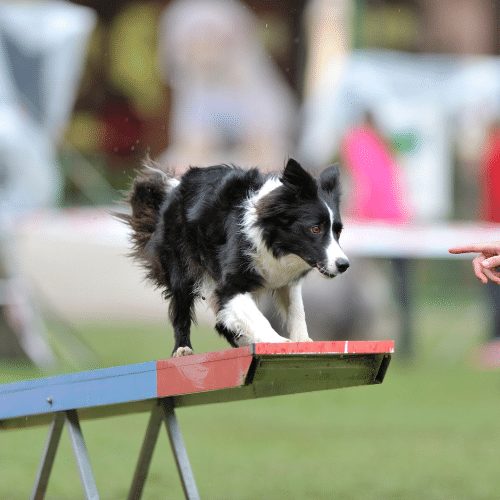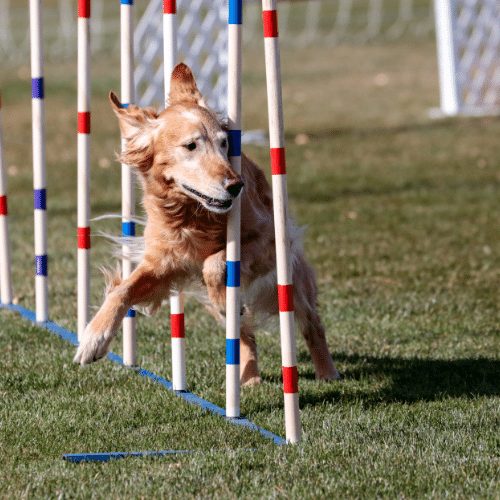How is dog agility scored?
April 25, 2021 2021-04-26 11:06Are you ready to enter your first agility competition and wondering how these are scored?
The quick answer is that agility is scored based on accuracy and speed. In order to qualify for earning a title or win a trial, your dog will have to be fast and flawless in his course performance.
Let’s look in detail at the way agility scores are determined and how many faults you incur for which obstacles.
Table of Contents

Dog agility scoring rules
The first and foremost focus of every agility run is accuracy. Accuracy will in most cases trump speed – meaning that a very fast dog who makes a mistake will probably lose against a slower dog who does not get faulted.
The agility course is numbered, with obstacles to be completed exactly in the order that they are set up in. That means:
- A dog cannot skip an obstacle
- A dog cannot take an additional obstacle
- A dog cannot take an obstacle from the wrong side
In addition, the individual obstacles also must be completed correctly.

Jumps
A dog will get faulted if he drops the bar of a jump. In addition, he will get a worse score if he takes the jump from the wrong side or “backjumps”. Backjumping is the act of taking a jump, turning around right away and taking it again.
This is the same for any type of agility jump. The rules are modified for speciality jump types. For example in the tire jump, there is no bar that the dog could drop. However, if he collides with the tire, he is faulted as well.
Contact equipment
All contact equipment is scored based on the dog’s performance in the yellow contact zones. A dog has to touch the contact zone before leaving the obstacle.
On the teeter the dog needs to touch the yellow as the teeter hits the ground. On the dogwalk and A-frame, the dog has to touch both contact zones at the beginning and the end of the obstacle in order to get a good score. On the pause table, the dog has to stay for a count of 5.
Weave poles
To get a clear score for the weave poles, the dog needs to complete all 12 poles on his first try. He has to enter the poles correctly, with the first pole on his left shoulder.
Popping out of the poles, entering incorrectly or running by the weave poles is scored as a fault.

Disqualifying faults
Some faults such as a dropped bar are not immediately disqualifying. Others will have you banned from the scoring right away. Such faults are:
- Taking a wrong obstacle
- Taking an obstacle from the incorrect side (which is essentially seen as taking a wrong obstacle)
- The handler touching the dog in any way – including colliding on while running
- The handler harshly disciplining the dog in a cruel way (such as by scolding, swatting, pushing etc.)
Agility speed scores
In most organizations (such as in AKC agility), there is a maximum time allowed for dogs to run a course. It is called the Standard Course Time (SCT). The SCT is calculated so that it allows nearly all dogs to easily make it. Any dog that is running instead of walking and does not get overly distracted will usually be within the given time frame.
Dogs do get disqualified if they have not completed the course by the time the SCT is over (usually around 60 seconds).
Dogs that do not complete the course under the SCT:
- Got distracted and stopped running the course
- Are very slow (so slow that they are not actually running, but walking)
After the SCT is over, the judge blows his whistle and the owner and dog have to leave the course.

Scores in beginner agility competitions
Many venues allow more relaxed rules for dogs and owners in the beginner classes. While some faults stay the same (such as for dropped bars or skipped contact zones), others are relaxed.
Refusals (dogs running around an obstacle or aborting the approach) are not counted and owners get a chance to redo refused obstacles. Faulty weave pole entries are also ignored and the dog is allowed to leave the weave poles and restart them.
These accommodations are to allow beginning dogs to enjoy the trial and owners to have successful experiences. As the dog moves up in skill, the rules become stricter.
Qualifying scores
The goal of every competitor is to earn what is called a “qualifying score”. These scores count towards certain titles. As long as a run is under the SCT and free of faults, it is a qualifying run (also called a “Q”). In higher levels of agility competitions you need several Qs. In AKC agility for example, QQs are required to reach the level of Master Agility Champion.
In USDAA handlers need so-called “Super Qs”.
In the lower level, it usually takes three qualifying runs to earn a title (such as the Novice Jumpers Title). In higher levels, you might need dozens of single or double Qs.
Score sheets and displays
In local trials, score sheets are printed and posted after a class has finished running. The first placements in each class get a special ribbon (such as a blue ribbon for first place).
In larger competitions, the scores might be displayed on screens in real time.
Generally, you do not have to strive to win a class by being the fastest, Consistency and accuracy go a long way. A dog with medium speed but great accuracy will do very well in competitions and earn a lot of qualifying scores and titles.

The bottom line
Dog agility scoring is not easy to understand for beginners. As a rule of thumb, remember that your dog needs to take all obstacles exactly in the order they are shown (without skipping obstacles, taking additional ones or taking the same obstacle twice). He also should not make a mistake in navigating each individual obstacle (such as by dropping a bar).
Until you get to the very competitive levels, you do not have to worry about speed as much. Accuracy goes a very long way.
A dog that is a bit slower, but consistent, will advance faster than a very quick dog who makes a lot of mistakes.


